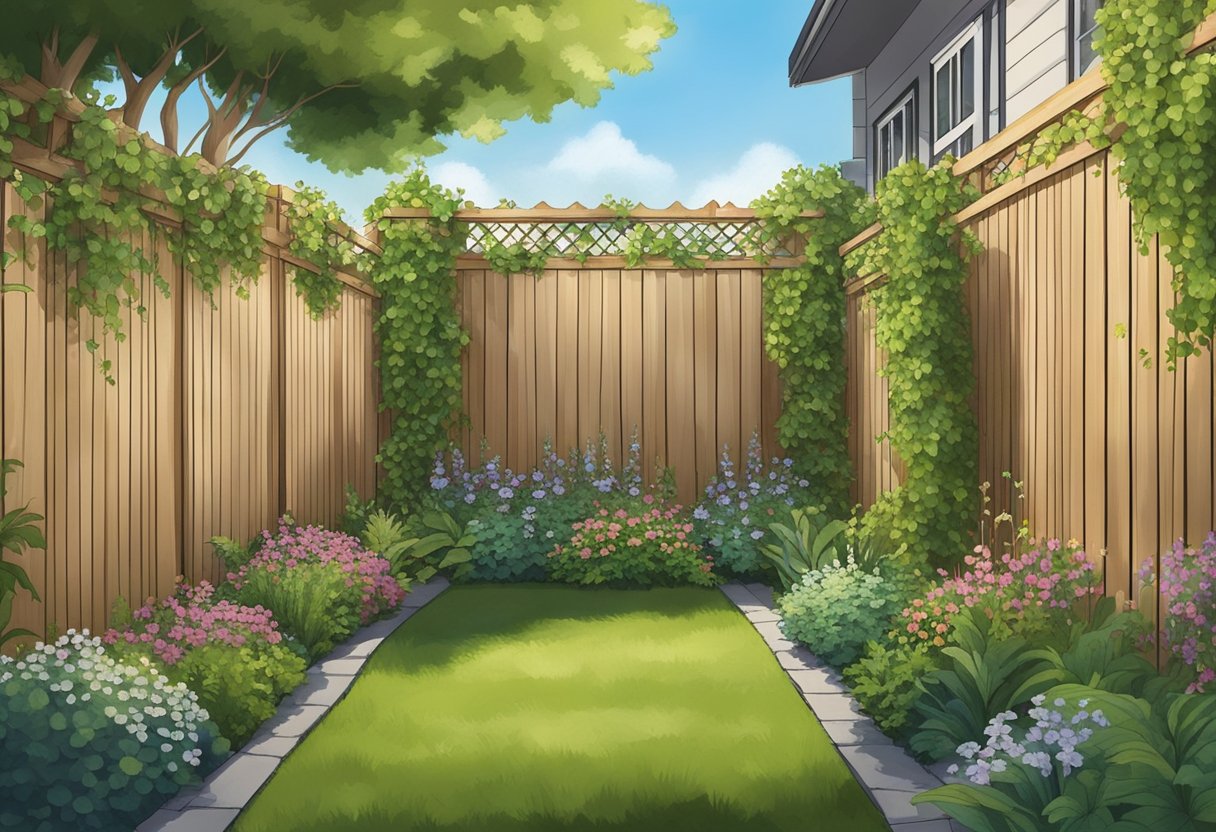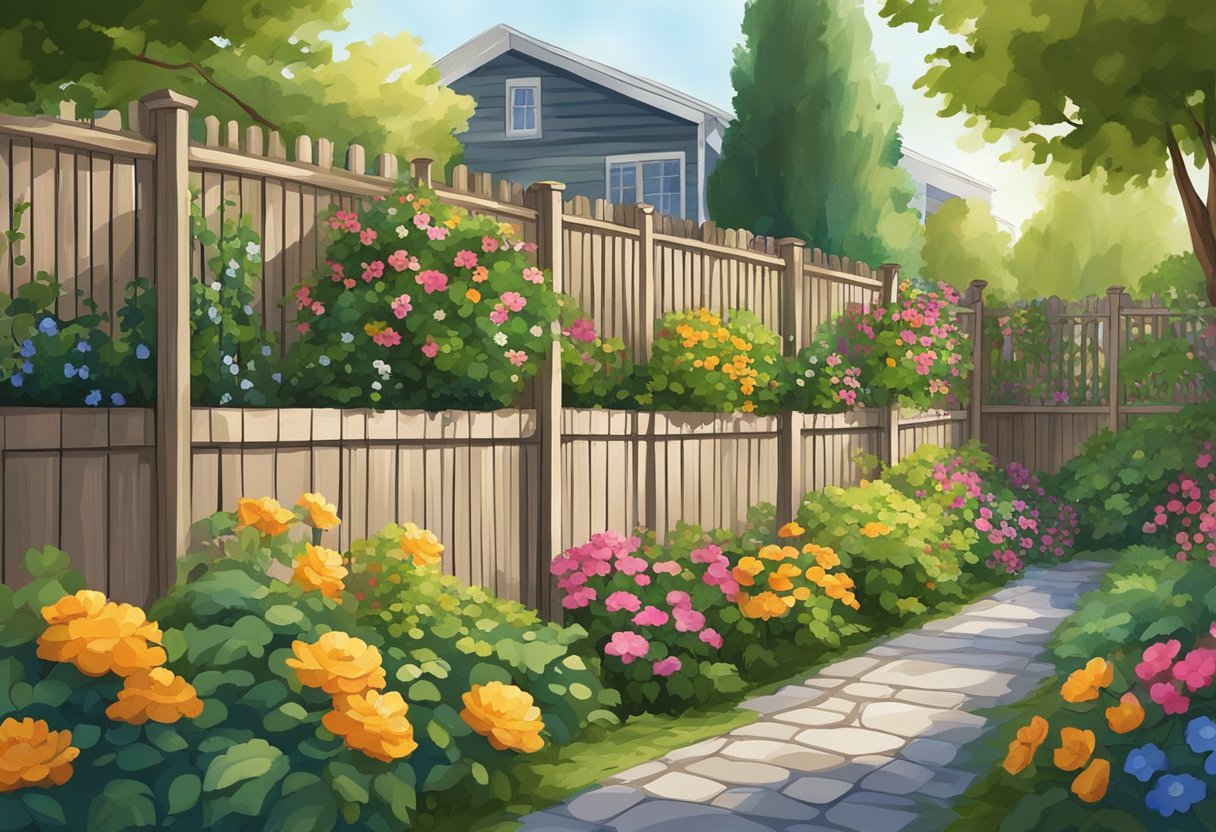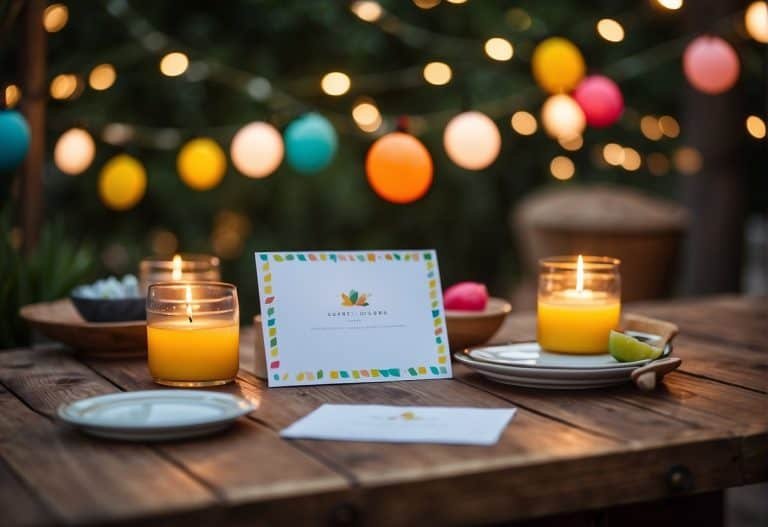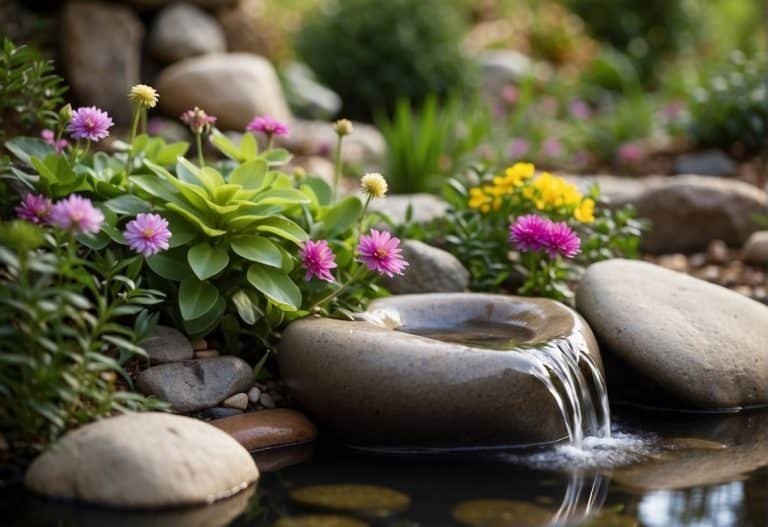8 Backyard Privacy Ideas from Neighbors That Will Transform Your Space
Nothing ruins a nice afternoon in the backyard than a nosey neighbor. We all value our outdoor space for relaxation, entertainment, and personal time.
And having privacy is key to enjoying these moments to the fullest. Whether you’re looking for natural ways to shield your space or considering structural enhancements, there’s a range of options to suit different tastes and budgets.
Let’s dive in.

We understand that everyone’s backyard is unique and so are the privacy needs that come with it. Combining function and aesthetics, privacy solutions can also enhance the visual appeal of your outdoor living area.
Table of Contents
Natural Privacy Solutions

One of the best ways to create a private backyard is by adding living elements that boost seclusion without sacrificing aesthetics.
We’re focusing on planting evergreens and using hedges and shrubs for their year-round lushness and dense growth, perfect for ensuring privacy.
Planting Evergreens for Year-Round Seclusion
Evergreens are the backbone of any privacy landscaping because they maintain their foliage throughout the seasons. Here’s a simple plan to get started:
- Choose the Right Species:
- Thuja ‘Green Giant’
- Leyland Cypress
- Holly
- Site Preparation and Planting:
- Test the soil and prepare it by adding necessary amendments for optimal evergreen health.
- Space the plants based on their mature width to avoid overcrowding and ensure a full, living screen.
Care Tips:
- Water newly planted evergreens regularly until established.
- Mulch around the base to retain moisture and suppress weeds.
- Prune as needed to maintain shape and density.
Utilizing Hedges and Shrubs

Hedges and shrubs offer a structured approach to privacy and can be tailored to suit any garden style. Here are key considerations:
- Decide on Formal or Informal: A formal hedge requires regular trimming for a neat appearance, while informal hedges are more casual and can include a mix of different shrubs.
- Selecting Varieties: Look for hedge plants that grow well in your USDA zone and meet the height requirements for your privacy screen.
Popular Hedge Plants:
- Boxwood
- Yew
- Privet
- Beech
When planting:
- Dig a trench the length of your desired hedge, rather than individual holes.
- Space the shrubs according to their mature spread to avoid gaps.
- Water consistently until the hedge is well-established.
By integrating evergreen trees and a variety of hedges and shrubs, we can create living fences that not only secure our privacy but also add to the overall greenery and beauty of our outdoor spaces.
Structural Additions for Privacy
When we’re aiming to enhance privacy in our yards, incorporating structural additions can make a significant difference. These structures are not only functional but can also elevate the aesthetic of our outdoor space.
Fences and Walls
Fences are a classic choice for privacy. We can consider a variety of materials:
- Wood fencing offers a traditional, warm look and comes in various styles, such as solid board or horizontal slats for a modern twist.
- A corrugated metal fence provides an industrial edge and is durable against weather.
- For those who prefer a blend of airiness with privacy, a lattice fence can serve beautifully, allowing some light and visuals while blocking direct view.
Walls, especially stone or masonry walls, are robust privacy solutions. They have the added benefit of sound-dampening and are highly durable. A retaining wall not only offers privacy but can also manage soil levels and add depth to garden design.
Some of the issues with fencing is can you build one high enough? Many cities have fence height limits so make sure to check your area before building your fence.
Elevated Structures
An elevated deck can be our secluded haven, especially if positioned strategically. By raising the deck, we’re physically above the direct line of sight from neighboring yards. Adding solid railings or privacy screens around the deck further ensures seclusion.
Creative Use of Garden Features
We can smartly integrate garden features for a natural screen:
- Vertical gardens: Installing these on fences or walls turns a plain privacy structure into a lush garden space.
- Trellises: Covered with climbing plants, they create a living wall that’s both green and private.
Innovative Privacy Enhancements
When we think about enhancing backyard privacy, we focus on the blend of functionality and aesthetics. Let’s explore a couple of innovative ways to do just that!
Decorative Panels and Screens
Decorative panels and screens are a superb choice for creating privacy with a modern twist. We have a range of materials to choose from, including metal, wood, and plexiglass, all of which provide different levels of opacity and style.
For instance, metal screens with intricate cutouts offer durability and a sophisticated look, while plexiglass panels permit light to pass through, keeping our space bright yet secluded.
- Metal Screens: Can be customized with various patterns.
- Plexiglass Panels: Provide a clear or frosted look for light transmission and privacy.
For a greener approach, faux living walls can mimic the look of real plants without the upkeep. These privacy panels come pre-assembled and can be easily installed to create an instant, lush green screen.
- Faux Living Walls: Low maintenance and instantly green.
Lattice and Trellis Incorporation
Lattice panels and trellises invite us to get creative with climbing plants, adding both privacy and a touch of nature to our yards. We can opt for a wooden lattice or metal trellis, and adorn them with fast-growing vines. This not only enhances privacy but also contributes to an ever-changing, live green screen that evolves with the seasons.
- Wooden Lattice: Ideal for supporting climbing plants like ivy or clematis.
- Metal Trellis: Robust and perfect for heavier vines.
Incorporating an arbor at the entrance of our garden not only punctuates the space with architectural interest but also supports a vertical garden when draped with vines. Planting bamboo along the borders gives us a rapidly growing natural screen that’s both exotic and effective.
- Garden Arbor: Acts as a grand entrance and a sturdy support for vines.
- Bamboo Planting: Creates a dense and tall natural barrier.
By using these innovative privacy enhancements, we can ensure our sanctuary remains both secluded and stylish.
Maximizing Privacy with Outdoor Living Areas
When we design outdoor living areas, it’s crucial to consider privacy for our patios and decks while creating secluded retreats that allow us to relax and unwind without the gaze of neighbors.
Patio and Deck Privacy
For our patios and decks, privacy can be achieved through strategic landscaping. We can plant hedges or bamboo, as these can grow to form natural barriers. Alternatively, installing wooden fences or lattices can provide immediate privacy and support for climbing plants. An added benefit is the sense of seclusion that these green walls offer.
- Privacy Screens: Freestanding screens made of wood or metal can be placed where needed.
- Retractable Awnings: Offer shade and privacy on demand and can be adjusted with the sun’s position.
To elevate our decks, building pergolas equipped with drapes or roll-down bamboo shades can grant a mix of privacy and shade. Incorporating container gardens with tall plants around our seating areas adds both greenery and an additional screen.
Add Shade Sail
If your neighbors have a second story and you’re trying to keep them from looking into your backyard, you might want to consider adding a shade sail strategically. If you can angle it correctly, then you’ll have privacy and possibly a little shade as well.

Creating a Secluded Retreat
In crafting our secluded retreat, we incorporate elements that add privacy while creating an inviting ambiance. A water feature, like a fountain or small pool, introduces soothing sounds that mask conversations and add to the sensory experience.
- Private Hammock Area: A cozy hammock tucked away in a corner, surrounded by tall plants and soft outdoor lighting, can be our little escape.
- Balcony Retreats: For those of us with balconies, using tall potted plants and bamboo screens can carve out a private nook.
On larger properties, placing seating away from property lines and using the natural landscape to obscure views can create an oasis. Where possible, strategically positioning outdoor living spaces out of direct sight lines from neighbors maximizes privacy without needing to build high structures.
Privacy Through Strategic Landscaping
We can cleverly use landscaping to create a private backyard oasis, shielding us from the eyes of neighbors while enhancing the beauty of our space.
Selective Plant Placement
- Trees: We choose trees that grow to an appropriate height, ensuring they’re tall enough to provide privacy where we need it most.
- Ideal Placement: We plant trees near the property line or in areas where we want to obstruct specific views.
- Canopy Formation: By planting trees with a dense canopy, we create a natural screen.
- Cascading Landscapes: To maximize seclusion, we incorporate layers of vegetation at varying heights.
- Raised Beds: Using raised beds allows us to elevate plants and add another level of privacy.
- Strategic Growth: We position cascading plants where they can grow over fences or walls, softening the landscape and providing additional screening.
Year-Round Landscape Maintenance
- Seasonal Considerations: You can get a year-round private retreat by choosing a mix of evergreen and deciduous plants.
- Evergreens: Serve as a continuous screen even in winter.
- Deciduous Trees: Provide dense foliage in warmer months.
- Regular Upkeep: We keep our landscape thriving and maintain our privacy with regular maintenance.
- Pruning: We trim trees to shape the canopy and control growth.
- Health Monitoring: We ensure plants remain disease-free and robust, preserving their screening ability.
Enhancing Aesthetic Appeal While Adding Privacy

When we talk about creating a private oasis in our backyards, it’s important to balance functionality with a visually pleasing design that complements our home’s character, and choose materials and colors that fit with the existing landscape.
Combining Function with Design
To effectively block the neighbors’ view and create a secluded space, consider using living privacy fences made of deciduous trees or climbers like ivy and roses. These plants not only enhance privacy but also add a touch of natural beauty as they change with the seasons. Incorporating a vertical garden can also serve as an attractive feature while maximizing space and privacy.
Think about adding a stylish parasol or some form of shade to create a shaded area where we can relax. This is not only practical but also adds to the overall appeal of the garden. The shade can make the space feel cooler and more comfortable during sunny days.
Choosing the Right Materials and Colors
Selecting the right materials is crucial for both aesthetics and privacy. For example, wooden pallets can be a cost-effective and versatile option for fencing; they can be painted to match our house’s exterior, creating a cohesive look. When using paint, choose colors that blend with the natural surroundings to make the privacy features seem like a natural part of the garden.
Ironwork can be shaped into beautiful designs, providing a sturdy and elegant boundary that offers privacy. Enlisting the help of an interior designer can help us choose ornamental ironwork that reflects our personal style while also serving a functional purpose.
| Materials | Privacy Function | Aesthetic Benefit |
|---|---|---|
| Deciduous trees | High | Seasonal beauty, natural look |
| Climbers like ivy | Medium to High | Greenery throughout the year |
| Parasol | Low | Offers shaded lounging area |
| Wooden pallets | High | Customizable with paint |
| Ornamental ironwork | High | Timeless elegance |
Remember, the right materials and colors can make the difference between a backyard that’s just secluded and one that’s both private and pleasing to the eye.
Seasonal Considerations for Backyard Privacy

Achieving backyard privacy is a year-round concern, but each season brings its own challenges and opportunities. In winter, deciduous plants lose leaves, requiring other strategies for continuous coverage. Throughout the year, utilizing seasonal plants can add beauty while maintaining privacy.
Adapting Privacy Features for Winter
During the winter months, we face the challenge of maintaining backyard privacy as many plants lose their foliage. This is where evergreens play a crucial role. These steadfast plants retain their leaves all year long, providing a permanent screen. To ensure continuous privacy:
- Install evergreen trees and shrubs such as pine, spruce, or holly.
Maintenance of these plants is also straightforward during winter; an occasional check to remove broken branches caused by snow will suffice.
Incorporating Seasonal Flora
For a multi-seasonal approach, we can add seasonal grasses, annuals, and perennials to our garden for dynamic privacy options. Here’s how to achieve this:
- Spring and Summer:
- Plant a mix of annuals and perennials for full coverage.
- Use fast-growing annuals in spots where an imminent screening is necessary.
- Fall:
- Tall grasses can create a visually arresting barrier that moves with the wind, adding beauty while obscuring views.
- Winter:
- Grasses that hold up well in the cold, like miscanthus, can remain attractive even in dormancy.
Integrating a combination of evergreens, grasses, and seasonal flowering plants not only gives us a beautiful living screen but also helps us adapt our privacy features with the changing seasons.
Do-It-Yourself Privacy Projects
In this section, we’ll show you how to create your own privacy solutions for your backyard with some DIY projects that are easy to handle and can greatly enhance your outdoor space’s seclusion.
DIY Privacy Ideas and Tips
Creating privacy in our backyards doesn’t have to be costly or complicated. We can start with something as simple as privacy screens. They can be crafted from a variety of materials like bunting, curtains, or corrugated metal depending on the look and level of privacy we desire.
- Privacy Fences: Wooden fence panels with close-able slats allow for adjustable privacy and airflow. These can be a weekend project using basic tools like a saw, hammer, nails, and wood stain.
- Trellis with Vines: A quick and eco-friendly option is to install a trellis and let climbing plants cover it. It not only offers privacy but also adds greenery to our space.
- Arbor as an Entryway: Arbors can double as both a decorative entryway and a support structure for climbing plants, creating a natural privacy curtain.
Building a Privacy Structure with Simple Tools
With basic tools that we often find in our sheds or garages – like a hammer, saw, drill, and screws – we can build a solid privacy structure. Our approach can be as straightforward or as customized as we please.
- Plan:
- Measure the area.
- Choose the design.
- Select materials.
- Construct:
- Outdoor Privacy Screen: For an area that needs a quick fix, pre-made panels are simple to install.
- Arbor: Building an arbor involves constructing two upright supports and a top piece, then adding lattice panels.
- Corrugated Metal Fence: This durable option provides a modern look but requires more tools like a metal cutter.
Frequently Asked Questions
In this section, we’ll address common inquiries on how to maintain a private outdoor space, touching on natural hedges, inventive fence enhancements, landscaping techniques, budget-friendly dividers, DIY projects, and considerate ways to deal with overlooking neighbors.
What are some effective plant-based hedges for ensuring privacy in my backyard?
Privacy can be elegantly ensured with plant-based hedges like Arborvitae, Bamboo, and Boxwood. We find these to be dense and fast-growing, providing a natural green barrier against prying eyes.
Can you suggest creative ways to increase privacy above my existing fence?
Adding lattice panels or trellises above the fence creates additional height and can be adorned with climbing plants. We also recommend decorative privacy screens or fence extensions with unique patterns.
What landscaping strategies can I use for a more secluded backyard?
We’ve found that layered planting, with tall trees accompanied by shorter shrubs and ground cover, creates a full privacy screen. Placing garden features such as pergolas or raised planters strategically can also obstruct unwanted views.
Could you provide some cost-effective yard divider solutions?
Freestanding bamboo screens or repurposed shutters can serve as cost-effective dividers. We encourage using large planters with tall grasses as movable screens that are both affordable and stylish.
What do-it-yourself projects could help enhance privacy in a small backyard?
Building a vertical garden or installing a simple slatted wood fence are excellent DIY projects that we’ve seen work wonderfully. These projects provide coverage without taking up too much space and can double as attractive garden features.
How can I tactfully create a more private outdoor space when dealing with second story neighbors?
Privacy sails or canopies can be a delicate solution. We recommend installing them at strategic angles to shield from viewing angles while maintaining good relations with your neighbors.






